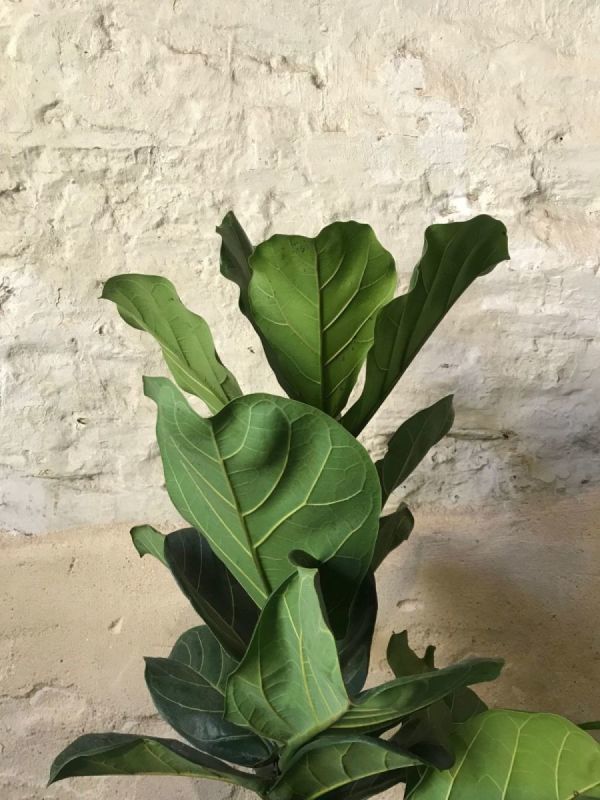
Ficus lyrata
Contents
- Top Tips
- Location, Water, Humidity & Fertilisation
- Common Issues
- Origins, Temperature, Propagation, Repotting & Toxicity
Need the answer to a specific plant query? Book a 1-to-1 video call with THE HOUSEPLANT DOCTOR™, the website's friendly author, to overcome and address your niggling problem! Available on iMessage, WhatsApp, Facebook Messenger & more.
Top Tips & Info
- Care Difficulty - Moderate
- Bright, indirect light is best, with slightly darker locations being accepted, too.
- Allow the soil' top third to dry out in between waters. It's recommended not to use the bottom-up method of submersion due to the risk of root rot.
- Although average humidity is acceptable, you can introduce a pebble tray or mist the foliage at monthly intervals to increase humidity & hydrate the leaves.
- Fertilise using a 'Houseplant' labelled feed every four waters in the spring and summer, reducing this to every six in the colder months.
- Repot every three years using a 'Houseplant' labelled potting mix. Be sure to respect the roots as transplant shock is a big issue that'll result in curling leaves.
- Keep an eye out for Spider Mites which are located along the ridges of the under-leaves.
Location & Light - 🔸🔸
A bright, indirect location is best for all-round growth. If you're feeling a little extra, provide an hour of morning or evening sunlight during the autumn and winter months to keep the plant satisfied over the darkened period. Fiddle-Leaf Figs that receive too much light will show symptoms of sun-scorch, that include pale-yellowed foliage, crispy brown patches and stunted growth. Alternatively, situations that don't boast enough light will result in slowed or elongated growth, mould developing on the soil and a heightened risk of root rot. Although most specimens will still do well in shadier spots, it's vital to decrease the amount of water to counteract the slowed rates of drying soil. Remember - the amount of light your plant receives will directly govern the frequency of waters that you should give.
Water - 🔸🔸
Allow a third of the soil to dry out between irrigations during the spring and summer, reducing this further through the colder months. Always use lukewarm water, and if you choose to use tap water, allow it to stand for at least 24hrs before application. Fiddle-Leaf Figs tend to be quite sensitive to temperature change, so pouring cold tap water immediately into the pot will cause nothing but grief in the likes of damaged roots. Under-watering symptoms include grey or yellowing leaves, yellow spots and stunted or deformed growth. Never allow the soil to thoroughly dry out for extended periods, especially in hot spells, as failure to do so could result in distorted growth. Over-watering symptoms include yellowing lower leaves, rotten plant sections and a softened stem. These issues are usually due to too little light or heat, too much water in between waterings, over-potting your specimen, or standing water beneath the pot.
Humidity - 🔸🔸
This species thrives in a reliable, humid environment, meaning that a pebble tray (or frequent misting) is mandatory for success. Signs of an under-humid room are primarily similar to inconsistent fluctuations, with slowed growth, browning leaf-tips and leaf loss being the common symptoms.
Fertilisation - 🔸🔸
Fertilise every four waters during the growing period before reducing this to every six in the autumn & winter. Although a 'General-purpose' fertiliser will still do the job, we'd recommend using a specific 'Houseplant' labelled fertiliser as it'll support the vital thirteen nutrients that this species will need to grow.
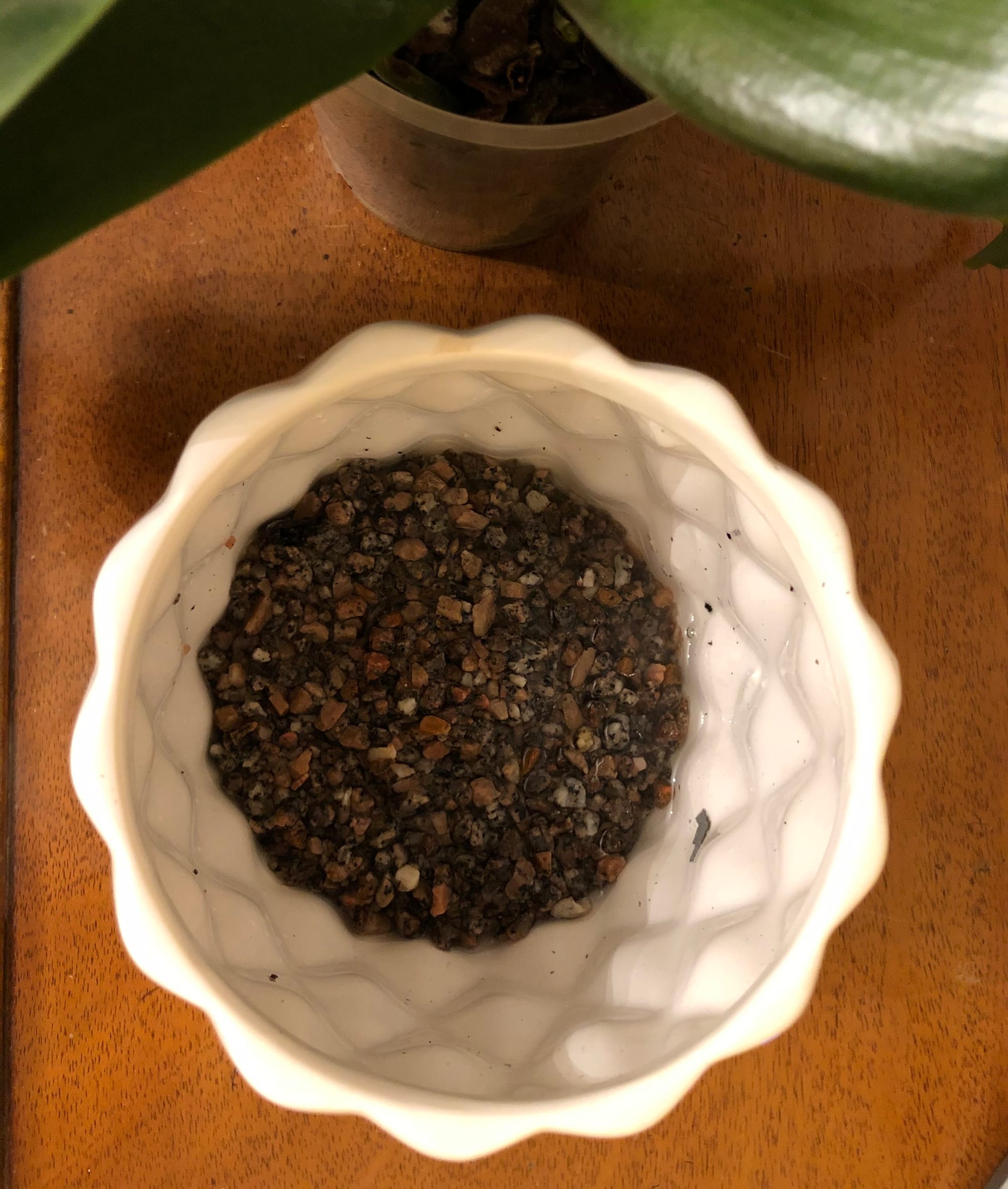 If you're forgetful with watering or battling with dry air, why not fill the decorative pot's bottom sixth with small grit? This will promote more reliable soil moisture that'll help encourage better growth & all-round health as the excess moisture will drain from the plant's plastic pot, thus creating a humid environment for root interaction.
If you're forgetful with watering or battling with dry air, why not fill the decorative pot's bottom sixth with small grit? This will promote more reliable soil moisture that'll help encourage better growth & all-round health as the excess moisture will drain from the plant's plastic pot, thus creating a humid environment for root interaction.
Common Issues with Fiddle-Leaf Figs
Lower leaf loss is a common and significant issue among gardeners. This unfortunate phenomenon could be a product of several different problems, most notably being dark locations, water-related abuse or environmental shock. Introduce the plant to a more well-lit area with a splash of off-peak sunlight; if caught in time, the leaf loss should stop within a week. It's always best to under-water Fiddle-Leaf Figs than over-do it, purely on its poor ability to endure continued sogginess. The final culprit could be down to a sudden relocation; if you've recently purchased the specimen, the chances are it is still acclimatising to the new environment. Although this shouldn't happen, a vastly different setting will cause sudden foliage loss and stunted growth. You'll have two options of either waiting it out or presenting a more Ficus-friendly environment, mentioned in the 'Location & Light' section. If you'd like to speak to ukhouseplants regarding this issue, don't be afraid to book a 1-to-1 call with THE HOUSEPLANT DOCTOR™ to help guide you through the step-by-step process!
Root rot is another common issue with specimens sat in too moist or waterlogged soil for long periods. Symptoms include rapidly yellowing leaves, stunted growth and a rotten brown base. Take the plant out of the pot and inspect health below the soil line. If the roots sport a yellow tinge, you're good to go, but if they're brown and mushy, action must be taken immediately. More information about addressing root rot can be found on this link. Scroll down to the last image to see an example of a healthy root system.
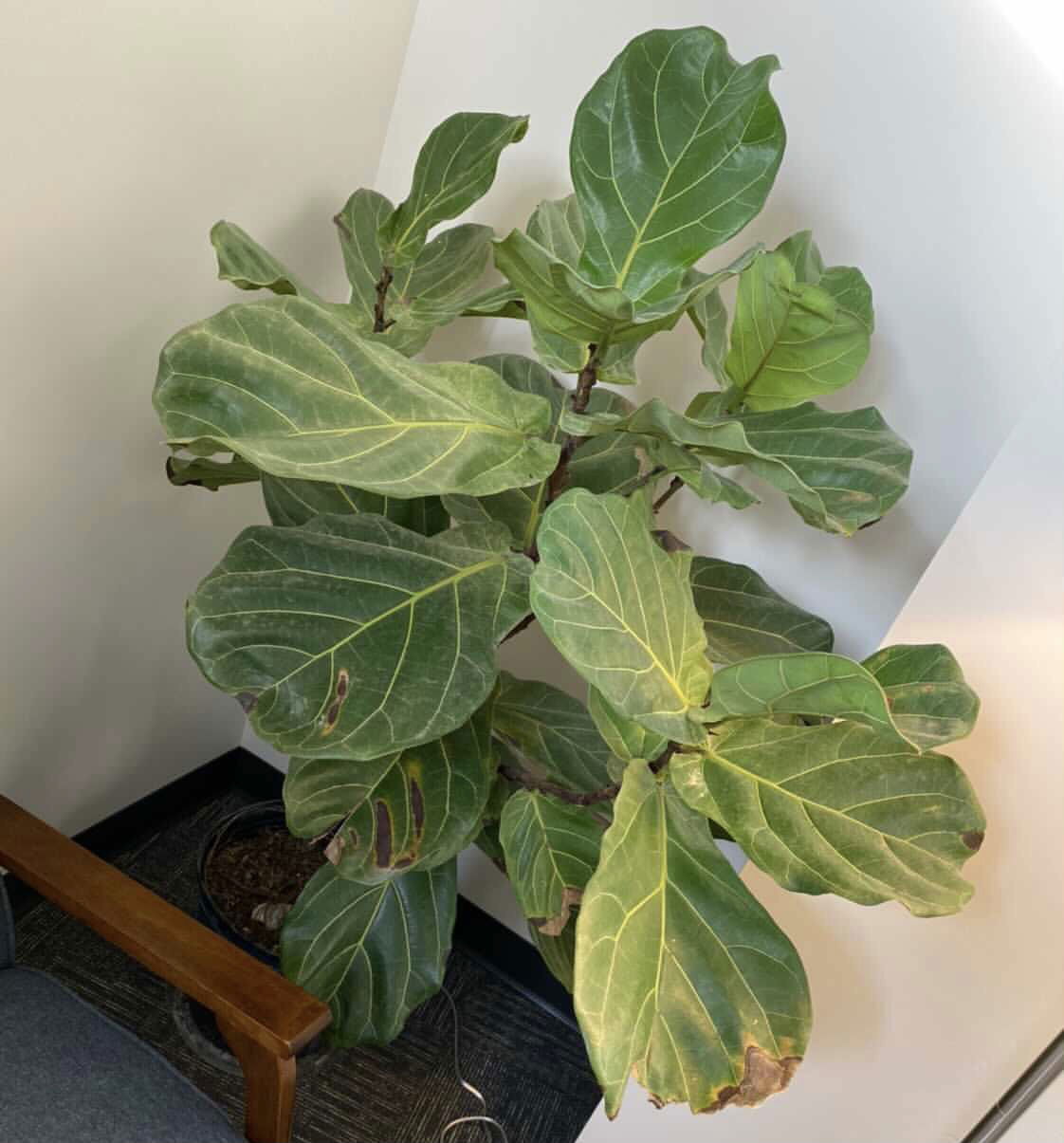 This specimen hadn't been fed for several months until it began developing these browned areas. It's important to fertilise your plant regularly (even through autumn and winter, albeit less frequently) to help the plant's overall health. If yours is beginning to look like this, increase fertilisation more and provide a brighter location. Prune off the most affected leaves and wait for new, healthier growth in the coming months!
This specimen hadn't been fed for several months until it began developing these browned areas. It's important to fertilise your plant regularly (even through autumn and winter, albeit less frequently) to help the plant's overall health. If yours is beginning to look like this, increase fertilisation more and provide a brighter location. Prune off the most affected leaves and wait for new, healthier growth in the coming months!
Yellowing lower leaves (closest to soil) are a clear sign of over-watering, usually caused by too little light. Although Fiddle-Leaf Figs can just about do well in a shaded environment, the frequency of irrigations must be reduced to counteract the chance of root rot. People don't realise that a plant's root system needs access to oxygen too; when soil is watered, the air will travel upwards and out of the potting mix. A lack of available oxygen for the roots will cause them to subsequently breakdown over the oncoming days. Click on this link to learn more about root rot and how to address it.
Always use lukewarm water, and if you choose to use tap water, allow it to stand for at least 24hrs before application. This species tends to be quite sensitive to temperature change, so pouring cold tap water immediately into the pot will not only add fluoride into the soil, but it could even cause yellowed leaf-edges over time.
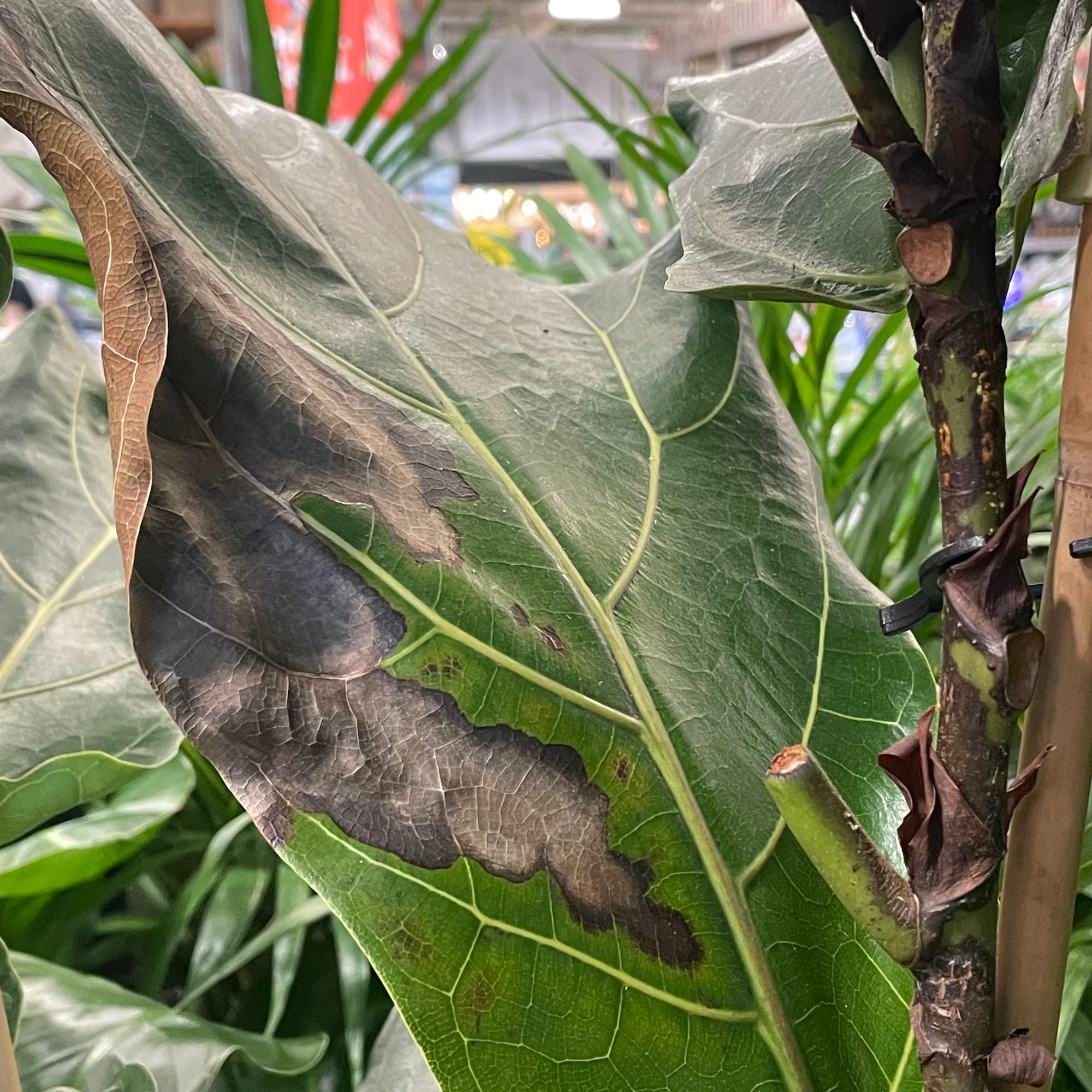 Low humidity or dry soil can be the culprit of this well-known issue amongst Fiddle-Leaf Fig growers. If your Ficus lyrata has leathery brown leaf-edges on its leaves, we recommend to relocate it within 1.5m (4ft) of a bright, indirect windowsill and feed every third water. Mist the foliage or hose the foliage in the shower every week. This plant also responds well to organic feeds.
Low humidity or dry soil can be the culprit of this well-known issue amongst Fiddle-Leaf Fig growers. If your Ficus lyrata has leathery brown leaf-edges on its leaves, we recommend to relocate it within 1.5m (4ft) of a bright, indirect windowsill and feed every third water. Mist the foliage or hose the foliage in the shower every week. This plant also responds well to organic feeds.
Curled leaves and brown leaf-edges are the result of too little water and over-exposure to the sun. This species is best located in bright, indirect settings, and those that haven't acclimatised to the harsh rays will show signs of sun-scorch and environmental shock. A splash of winter sunlight is acceptable as long as the soil moisture is regularly observed, with complete avoidance once summer comes along.
Too low humidity can cause browning tips with yellow halos on juvenile leaves. Although this won't kill your specimen, you may want to increase the local moisture to prevent the new growth from adopting these symptoms. Mist or rinse the foliage from time to time and create a humidity tray while the heaters are active to create a stable environment. The browning of leaf-tips on older leaves is wholly natural and is the product of extensive photosynthesis during its life.
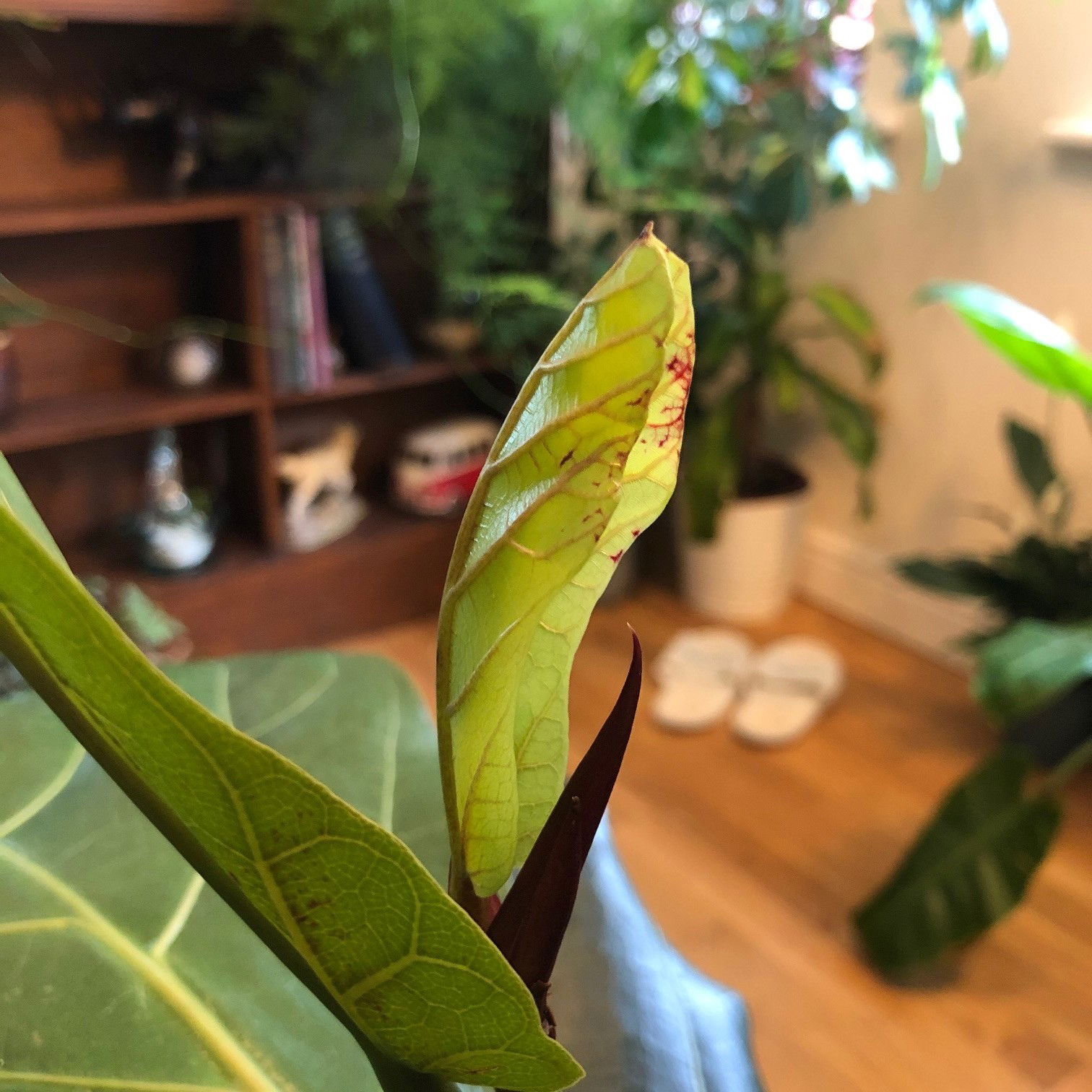 The red spots or veins of a leaf are called 'oedema' and are the direct product of water-stress. This is where the roots are absorbing more moisture than can be transpired through the stomata, which in turn results in blistered veins. Although it's relatively harmless, you may want to re-evaluate your watering regime to avoid this occurring again on future growth.
The red spots or veins of a leaf are called 'oedema' and are the direct product of water-stress. This is where the roots are absorbing more moisture than can be transpired through the stomata, which in turn results in blistered veins. Although it's relatively harmless, you may want to re-evaluate your watering regime to avoid this occurring again on future growth.
Never allow temperatures to dip below 15ºC (59ºF) as irreversible damage will occur in the likes of yellow foliage and weakened health. When this happens, remove the severely affected areas and immediately improve growing conditions - never cut through softened yellow growth, and only around brown, crispy squares. As rehabilitation can take several months because of its slow-growing nature, be sure to provide a stable location with better growing conditions to speed this process.
If your specimen is located in a dark environment, use a chopstick to gently stab the soil in various areas. You should aim to enter the compost between the base of the plant and the pot's edge, as failure to do so may lead to damaging its lower portion. Leave the holes open for a few days before re-surfacing the soil to avoid it becoming overly dry. Not only will the gentle shift in the soil's structure mimic the work of small invertebrates in the wild (worms, etc.), but it'll also add oxygen back into the soil, thus reducing the risk of root rot. Repeat this monthly, or whenever you feel the potting-mix isn't drying out quickly enough.
The yellow spots that form along the outer edges of the leaves are called cystoliths; they are entirely harmless to your Fiddle-Leaf Fig and will form once the leaf hardens & matures.
Origins
Ficus is a pantropical genus consisting of over 800 species, first described by Carl Linnaeus in 1753. Many species uniquely rely on a specific wasp, dubbed the Fig Wasp, to pollinate its flowers by laying eggs into the ostioles, a process that still baffles botanists today. The species, F. lyrata, was first described in 1894 by Otto Warburg, who referenced the lye-shaped leaves in its name. It is endemic to central-west Africa.
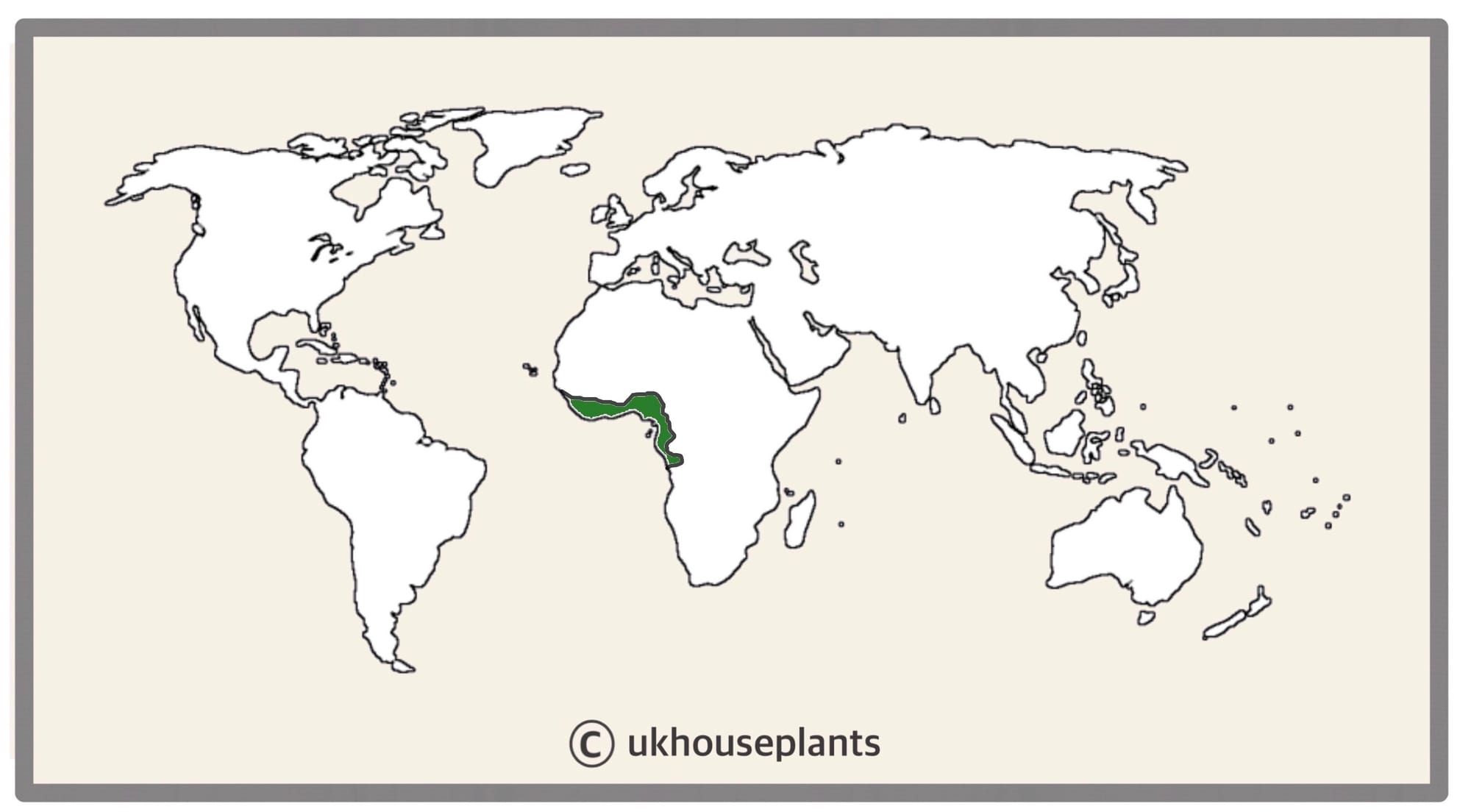 A Distribution Map of Ficus lyrata.
A Distribution Map of Ficus lyrata.
Temperature
15° - 26°C (59° - 80°F)
H1a (Hardiness Zone 13) - Must be grown indoors or under glass all year round. Never allow temperatures to dip below 15℃, or situate it near to a cold draught as permanent damage will occur in the likes of leaf loss and stunted growth.
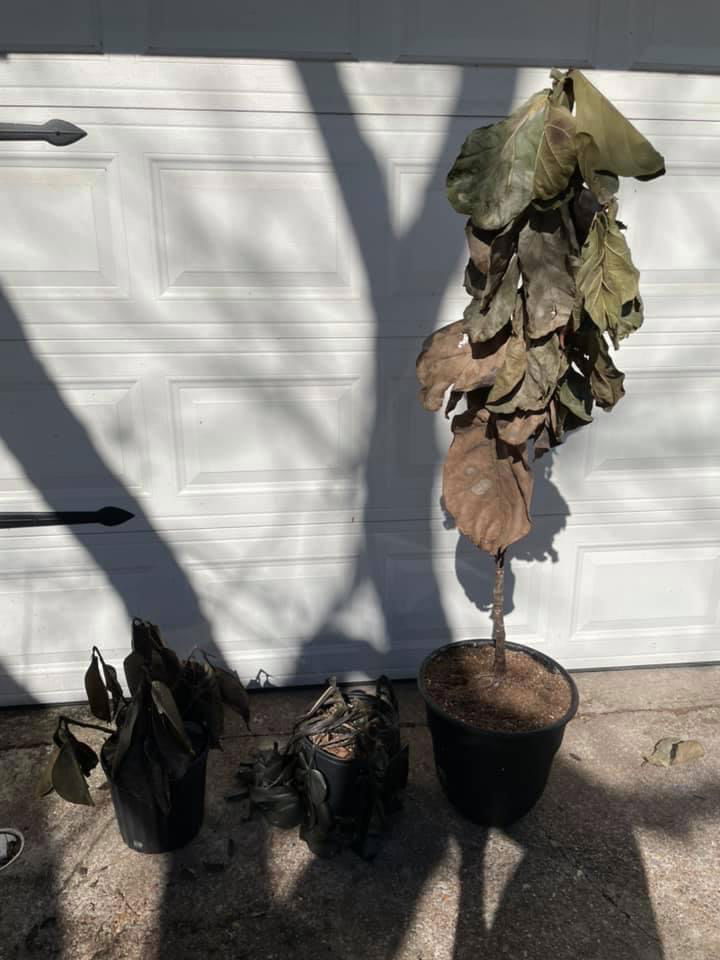 Irreversible temperature damage to a Fiddle-Leaf Fig. Credit: Facebook.
Irreversible temperature damage to a Fiddle-Leaf Fig. Credit: Facebook.
Spread
Up to 4m in height and 1.5m in width. The ultimate height will take around 10 years to achieve, with 12cm of growth per season.
Pruning & Maintenance
Remove yellow or dying leaves, and plant debris to encourage better-growing conditions. While pruning, always use clean scissors or shears to reduce the chance of bacterial and fungal diseases. Never cut through yellowed tissue as this may cause further damage in the likes of diseases or bacterial infections. Remember to make clean incisions as too-damaged wounds may shock the plant, causing weakened growth and a decline in health.
Propagation
Via Seed or Stem Cuttings (Difficult).
Stem & Eye Cuttings (Moderate) - This method of propagation is troublesome without the aid of bottom-heat and a controlled environment. Choose the healthiest, most established stems that are wooded, yet still juvenile enough to bend slightly, being just thicker than a pencil. Each cutting should only have ONE leaf, and a small portion of the stem to either side of the node. Cut directly below a node using a clean knife to reduce bacteria count. Situate the cutting into moist 'Houseplant' compost, with the only the leaf sticking out of the soil. Blackleg can occur when the bottom wound becomes infected, resulting in propagation failure - typically caused by water-logging or a too-damaged wound. Maintain bright light and evenly moist soil with the avoidance of direct sunlight or cold draughts. Wrap the pot (& foliage) in a transparent bag or within a miniature greenhouse, and provide bottom hear of temperatures above 18°C (54°F). Remove the bag and place into individual 7cm (3 inches) pots once the second new leaf emerges. Follow the same care routines, as mentioned in the article's top half. This method will take up to five months, so patience and the correct environment are paramount for success!
Flowers
Ficus lyrata inflorescences consist of white flowers developing in early springtime that can vary in size. This period will last up to several weeks and will from berries if pollination is successful. Unfortunately, all Ficus are highly unlikely to flower if grown domestically, due to the incorrect environmental conditions found in a typical home.
Repotting
Repot every three years in the spring, using a 'Houseplant' labelled compost and the next sized pot with adequate drainage. Hydrate the plant 24hrs before tinkering with the roots to prevent the risk of transplant shock. For those that are situated in a darker location, add a thin layer of small grit in the pot's base to improve drainage and downplay over-watering. Click here for a detailed step-by-step guide on transplantation, or via this link to learn about repotting with root rot.
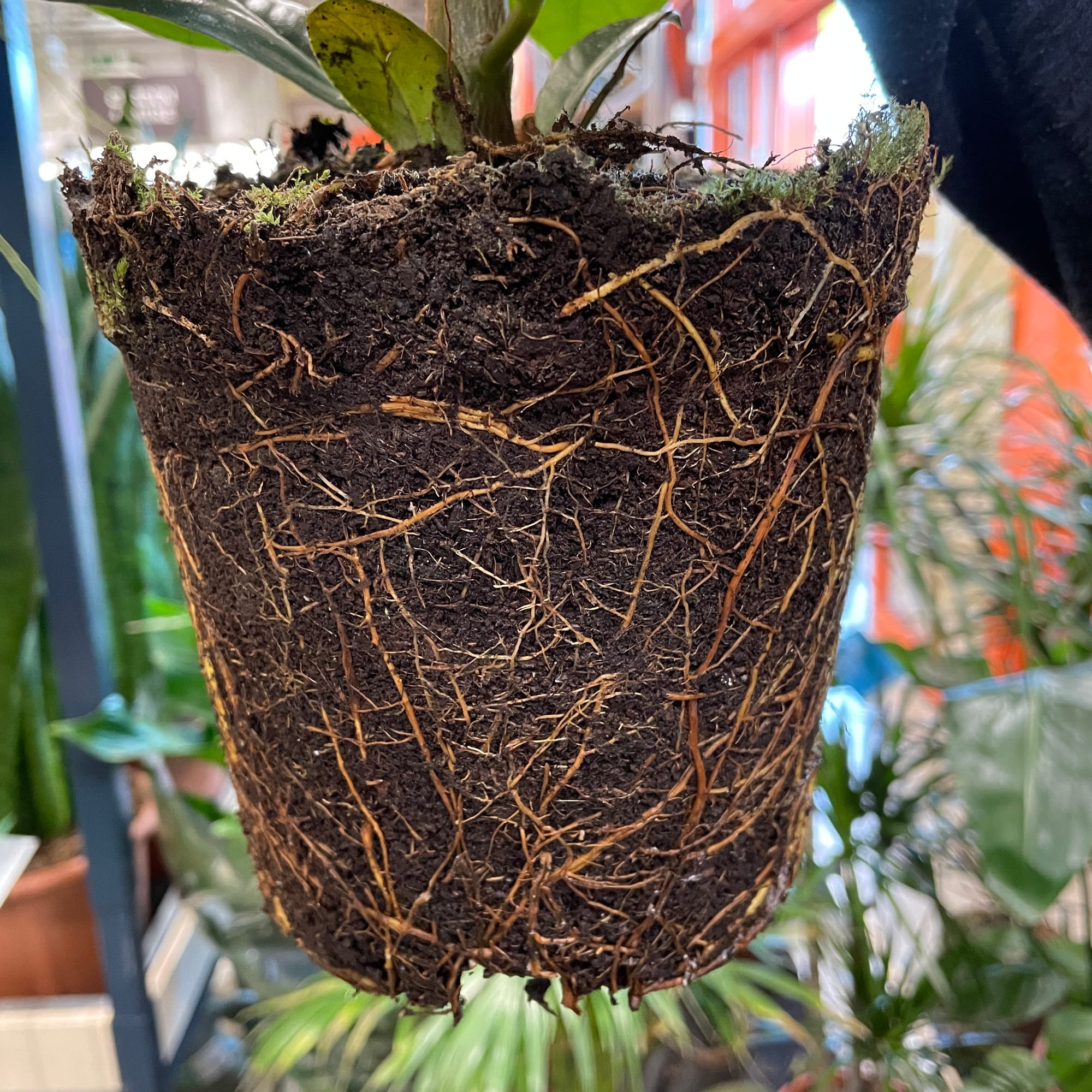 Here's an example of a Fiddle-Leaf Fig's healthy root system.
Here's an example of a Fiddle-Leaf Fig's healthy root system.
Pests & Diseases
Keep an eye out for mealybugs, aphids, spider mites, scale, thrips, whitefly, blackfly & root mealybugs that'll locate themselves in the cubbyholes and undersides of the leaves, with the exception of the latter in the soil. Common diseases associated with Fiddle-Leaf Figs are root rot, leaf-spot disease, botrytis, rust, powdery mildew & southern blight - click here to learn more about these issues.
If the specimen has dry white crusty patches on its foliage or stem, this is its sap, commonly caused by damage via touch.
Toxicity
This plant is classified as poisonous; if parts of the plants are eaten, vomiting, nausea and a loss of appetite could occur. Consumption of large quantities must be dealt with quickly; acquire medical assistance for further information. The sap can also cause dermatitis and skin allergy to sensitive individuals, so be sure to wear gloves when handling.
Retail Locations
B&Q, Blue Diamond, Dobbies & Online Stores.
https://www.ukhouseplants.com/call-the-houseplant-doctor
If you need further advice with your houseplants, book an advice call with ukhouseplants' friendly and expert writer today! This can be done via a video or audio call on most apps, including Facebook, FaceTime & Skype. A ten-minute call costs £5.99 (US$7), or £15.99 for thirty minutes. You can ask multiple questions, including queries on plants, pests, terrariums, repotting advice and anything in between. Please consider supporting this service to keep ukhouseplants thriving!